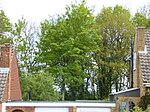St Giles' Church is an Anglican church in the village of Horsted Keynes in Mid Sussex, one of seven local government districts in the English county of West Sussex. Serving an extensive rural parish in the Sussex Weald, it stands at the north end of its village on the site of an ancient pagan place of worship. The present building succeeds the original wattle and daub church, its wooden successor and a Saxon stone building—although the Norman architects who erected the cruciform structure in the 12th century preserved parts of the Saxon fabric.
Long established local families have been important in the life of the church for centuries, as indicated by the extensive range of memorials and fittings in the building and its large churchyard. The village got its name from the de Cahaignes family, one of whose ancestors is apparently commemorated by the rare 13th-century "heart shrine" in the chancel. Another family with more recent connections to the parish is the Macmillan publishing dynasty, the most famous of whose sons—former Prime Minister Harold Macmillan—is buried in the family plot.
Various changes have been made to the Norman church, mostly in the 13th and 14th centuries, and some Victorian restoration was undertaken. Nevertheless, the building still retains its original cruciform shape and its central tower topped by a landmark broach spire. The church continues to play an active part in parish life, maintaining links to the local school and holding regular services. English Heritage has listed it at Grade I for its architectural and historical importance.











